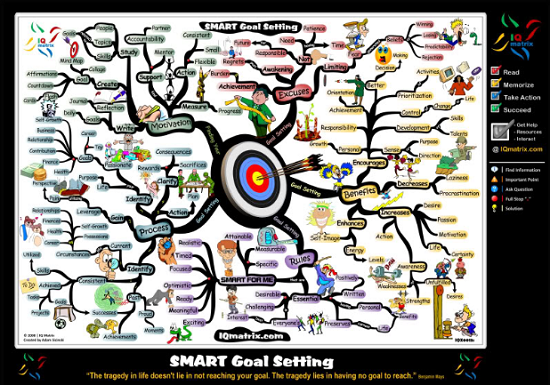SMART Goals Clobber New Year’s Resolutions—Five to Nothing

Skip the unattainable resolutions this New Year. Instead, set SMART goals that lead to success. How many years have you made those same New Year’s resolutions only to have broken them by the third week in January? Raise your hands a little higher, please. It seems unanimous. We have all done that, but wait what about you in the back. Why didn’t you raise your hand?
You ditched resolutions as being too vague? It’s true we all say we are going to lose weight this year only to watch the scale tell us we did otherwise. I guess that resolutions are a little vague. So what have you done differently and can we benefit from it in a business sense as well as a personal one?
Why not set some goals? How do you know what kind of goals to set? The whole point of setting goals, after all, is to achieve them. It won’t do you any good to go to the trouble of calling meetings, rushing your employees through the needs of your organization, and burning up precious time, only to end up with goals that aren't acted on or completed. It is better to set goals together with your employees.
The best goals are smart goals — well, actually SMART goals is more like it. SMART is an acronym for the five aspects of well-designed goals. Remember that you can apply this equally to your personal life as to your business. SMART stands for:
- Specific
- Measurable
- Attainable
- Realistic
- Timely
Specific:
A specific goal has a much greater chance of being accomplished than a resolution. Goals must be clear and unambiguous; vagaries and platitudes have no place in goal setting. When goals are specific, they tell employees exactly what is expected, when, and how much. Because the goals are specific, you can easily measure your employees' progress toward their completion.
To set a specific goal you must answer the six “W” questions:
*Who: Who is going to do this task?
*What: What do I want myself or my team to accomplish?
*Where: Spell out the location.
*When: Decide on an exact time frame.
*Which: List what are the requirements and constraints.
*Why: Give specific reasons, purpose or benefits of achieving the goal.
EXAMPLE: A resolution would be, “Add blogs to website.” But a specific goal would say, “Write informational blogs on Monday, Wednesday and Friday.”
Measurable:
Establish concrete criteria for measuring the progress toward reaching each goal you set. What good is a goal that you can't measure? If your goals are not measurable, you never know whether your employees are making progress toward their successful completion. Not only that, but it's tough for your employees to stay motivated to complete their goals when they have no milestones to indicate their progress.
When you are able to measure progress, you or your team will stay on track, reach target dates, and experience the exhilaration of achievement that spurs all on to a continued effort to reach your goal.
To determine if your goal is measurable, ask questions such as……
How much? How many?
How will I know when it is accomplished?
Attainable:
When you identify goals that are most important to you or your business, you begin to figure out ways you can make them come true. Your employees develop the attitudes, abilities, skills, and financial capacity to reach them. You and your team begin seeing previously overlooked opportunities to bring yourself closer to the achievement of your goals. You can break those large goals into bite-sized pieces that can be attained by certain times.
You can reach almost any goal you set when you plan your steps wisely and establish a time frame that allows you to carry out those steps. Goals that may have seemed far away and out of reach eventually move closer and become attainable, not because your goals shrink, but because you grow and expand to match them. Goals need to encourage growth, not limit it. When you list your business goals you build your employees self-image. Employees see themselves as worthy of these goals, and develop the traits and personality that allow them to possess them.
Realistic:
To be realistic, a goal needs to represent an objective toward which you are both willing and able to work. A goal can be both high and realistic; you and your employees are the only ones who can decide just how high the goal should be. But be sure that every goal represents substantial progress. Goals must be an important tool in the grand scheme of reaching your company's vision and mission. Be sure that you break those high goals into doable steps that show progress.
A high goal is frequently easier to reach than a low one because a low goal exerts low motivational force. Some of the hardest jobs you ever accomplished actually seem easy simply because they were a labor of love.
Timely:
Goals must have starting points, ending points, and fixed durations. Commitment to deadlines helps employees focus their efforts on completion of the goal on or before the due date. Goals without deadlines or schedules for completion tend to be overtaken by the day-to-day crises that invariably arise in an organization. A goal should be grounded within a time frame. With no time frame tied to it there’s no sense of urgency. If you want to have 3 blogs published on certain keyword phrases per week, when do you want to start doing this? “Someday” won’t work. But if you anchor it within a timeframe, “by May 1st”, then you’ve set your unconscious mind into motion to begin working on the goal.
Your goal is probably realistic if you truly believe that it can be accomplished. Additional ways to know if your goal is realistic are to determine if you have accomplished anything similar in the past or ask yourself what conditions would have to exist to accomplish this goal.
SMART goals make for smart organizations as well as smart individuals. Many supervisors and managers neglect to work with their employees to set goals together. By developing SMART goals with your employees, you ensure the progress of your organization and its employees.
Have you developed SMART goals? Were you able to attain them? Have you carefully examined those goals that did not work out to see what went wrong? Please add your experiences to the box below.
 Jaco Grobbelaar is the owner of BroadVision Marketing. BroadVision Marketing works with business owners to put in place inbound and outbound marketing strategies that consistently secure new clients. The BroadVision Marketing Training Center is located in Petaluma, CA and primarily serves companies in the San Francisco Bay area.
Jaco Grobbelaar is the owner of BroadVision Marketing. BroadVision Marketing works with business owners to put in place inbound and outbound marketing strategies that consistently secure new clients. The BroadVision Marketing Training Center is located in Petaluma, CA and primarily serves companies in the San Francisco Bay area.
Jaco can be reached at jaco@broadvisionmarketing.com or 707.766.9778 or connect with Jaco on Facebook - www.facebook.com/broadvisionmarketing - and LinkedIn - www.linkedin.com/in/JacoGrobbelaar.
You May Also Like
These Related Stories

Are SMART Goals Really Dumb?

Local Inbound Marketer Advice: Get SMART



No Comments Yet
Let us know what you think